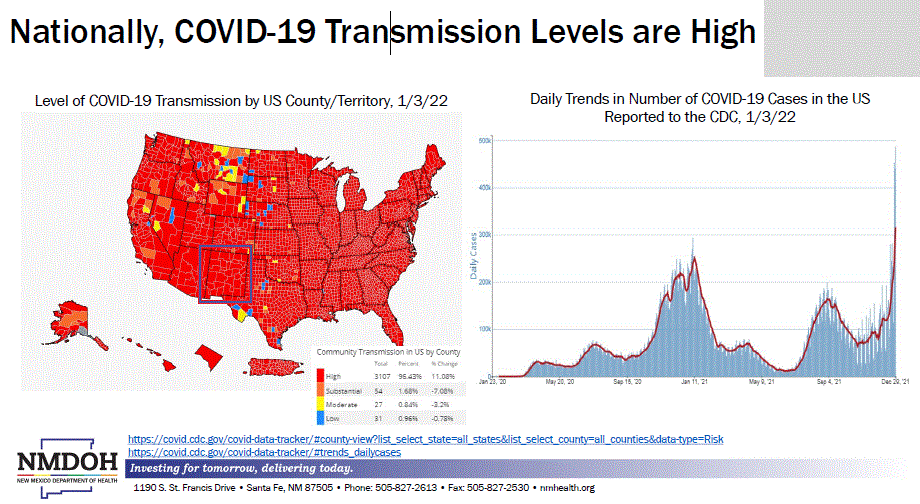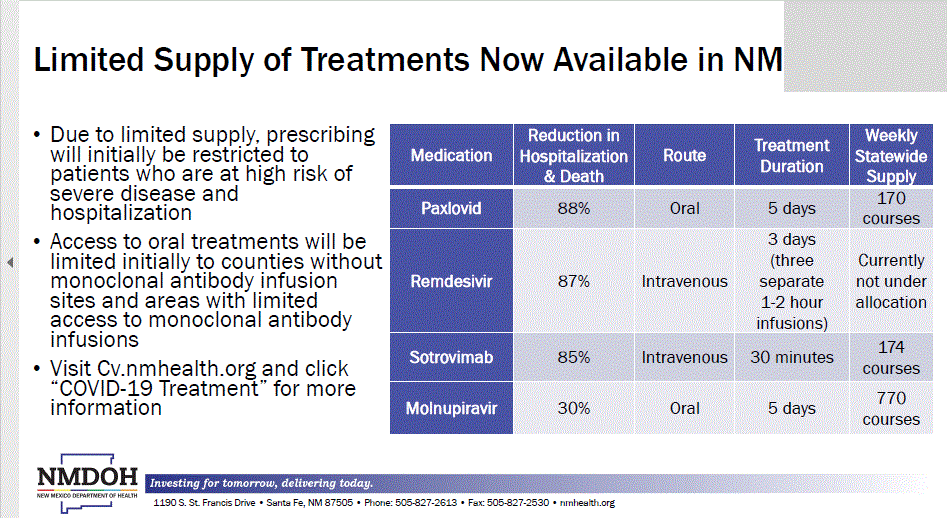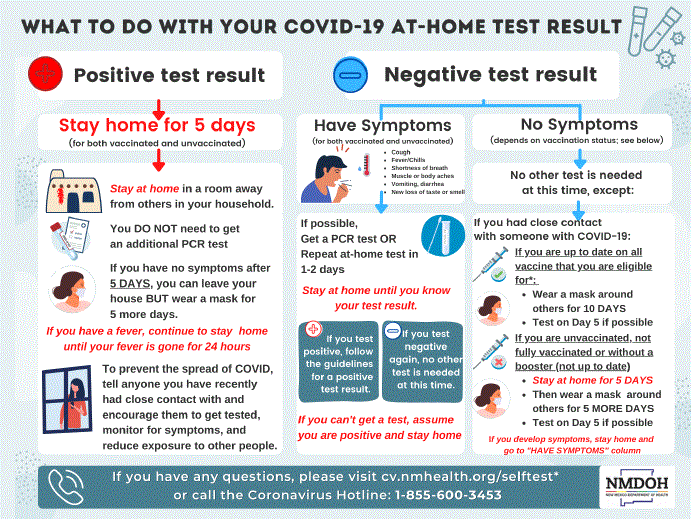On January 5. 2022 the New Mexico Department of Health held its weekly press conference. That press conference reinforces my belief that it is difficult to figure out what is going on with COVID-19 and all its variants. It is not clear to me that what is going on is part of any coherent plan. I will discuss all of this in the body of this article. For those who want to know more about the presentation, I have provided some links at the end of this article.

Pandemic Crisis Management
The major strategy used by New Mexico has been to encourage:
- Vaccinations
- Social distancing
- Wearing of masks
- Washing of hands
- Testing
- Reallocating medical resources to where needed and seeking to obtain additional resources.
Thus one could correctly say that New Mexico is firmly wedded to CDC guidelines. Our Governor has been very determined with respect to vaccinations. Not everyone in New Mexico agrees with her approach.

I do not want to give the wrong impression by an earlier statement. New Mexico has an excellent COVID-19 website but the image used in the presentation was not easy to follow, So I elected to use the CDC nationwide graphic as it makes the point I wanted to make. The New Mexico website can be found at https://cv.nmhealth.org/.
The CDC graphic shows similar information but for the whole U.S. What is important is that it shows a number of waves of increasing numbers of cases. I see six waves of which perhaps four are most significant:
- There was the initial wave of infections.
- Then there was a major outbreak at the end of 2020.
- Next there was another major outbreak between the summer and fall of 2021.
- Now there is a steep increase in cases attributed to the Omicron variant.
Ending the Pandemic
So far there has been no way to end what is a pandemic in the U.S. and the World. Many believe vaccinations have been helpful to both reduce both the rate and severity of infections – and also to moderate the impact on the healthcare system.

This is about one month of New Mexico data. It appears to show that vaccination has reduced the medical impact of COVID-19 on those who have been vaccinated. I am not showing the graphic but New Mexico has a high level of vaccination. The breakdown by age group etc. is in the set of slides for which a link is provided at the end of this article.
Before continuing, I want to point out what is not being covered in this article:
- Economic impacts of COVID-19 on New Mexico
- Effectiveness of policies at minimizing the impacts of COVID-19 on individuals and the healthcare system
- Impact of policies to minimize the impacts of COVID-19 on the overall health of New Mexicans
- Impact of policies to minimize the impacts of COVID-19 on the economy of New Mexico
Certainly one can attempt to focus on a smaller (.e.g. county or zip code) or larger (e.g. region or the entire U.S.). But sometimes looking at a more local situation provides insights missed when you look at a larger area. It seems to me that this recent presentation was useful because it took place during the transition from Delta to Omicron – and before those involved had had a chance to figure out how they might have to change their approach.
My purpose here is to raise the question of how Omicron and Future Variants may impact the current strategy, using New Mexico as an example.
Delta, Omicron, and Future Variants
But things seem to be changing. Some of the changes include:
- There is now more use of home COVID-19 tests and many of these are not reported so they do not show up in the data.
- We do not know for sure but the ratio of asymptomatic cases for Omicron compared to Delta may be higher than reported.
- It is less clear why a person is admitted to a hospital. There are significantly more cases of Omicron discovered when a person admitted for some other reason is tested for COVID-19. But it is not clear that the COVID-19 infection did not contribute to the need for the patient to be admitted to a hospital. That is an area of research that has just begun.
- It is too soon to tell but it is likely that it will be very difficult to determine the cause of death of those who die while being infected with the Omicron Variant.
Thus there are many questions now on how to track Omicron and even if we should. There will be similar questions on when to treat and how to treat. An example of the problem: Should a person with cold symptoms be tested if the testing process itself has a risk of that person contracting Omicron?
The Omicron Spike
On the other hand, we know that this spike in cases far exceeds our ability to treat.

This was the situation with medications on January 5, 2022, in New Mexico. The situation is expected to improve. Most people would not be happy to be told they were being treated with a medication that was 30% effective. That is an assumption on my part. The point is simple. We need to hope that Omicron is not too impactful to a large number of people – and that we can tell who needs to be treated.
The infographic below is intended to be a guide for what people should do. A lot of work was done on that guide. I personally would prefer that it have been put into a flow chart format but it is what it is.

Endemic COVID
Some are hopeful that the Omicron surge will end the Pandemic and reduce COVID-19 to a manageable endemic status. It seems to me that this will require certain things to transpire such as:
- There is not a high reinfection rate of people who have been infected with Omicron.
- The medical impacts of Omicron turn out to be as mild as we currently have some reason to believe.
- There are not new variants that are more problematic than Omicron.
On the other hand, there may be a vaccine that is very effective against all variations of COVID-19 – or even all corona viruses.
I hope you found this article helpful. For those who want more information here is a link to the TV coverage of the presentation https://www.krqe.com/health/coronavirus-new-mexico/new-mexico-health-leaders-to-provide-update-on-states-covid-19-trends/
Here is a link to the slides used in the Press Conference https://cv.nmhealth.org/wp-content/uploads/2022/01/20220105-Press-Conference-FINAL.pdf